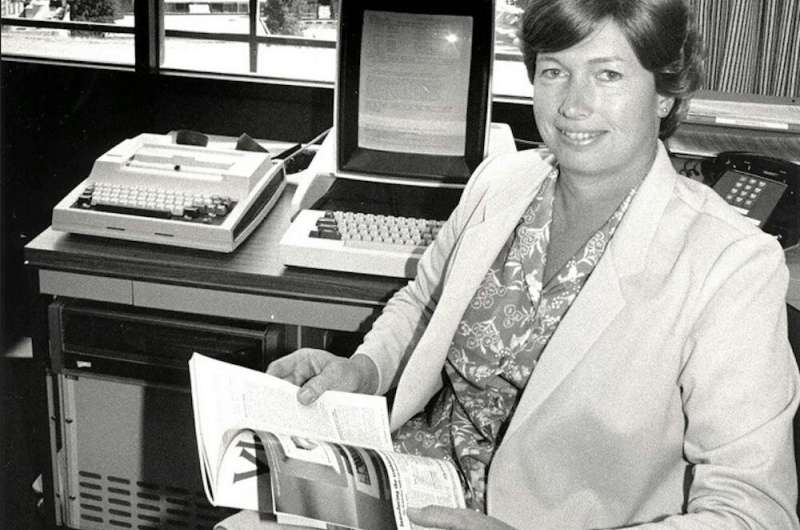This article has been reviewed according to Science X's editorial process and policies. Editors have highlighted the following attributes while ensuring the content's credibility:
fact-checked
trusted source
written by researcher(s)
proofread
Lynn Conway was a trans woman in tech—and underappreciated for decades after she helped launch the computing revolution

Lynn Conway may hold the record for longest delay between being unfairly fired and receiving an apology for it. In 1968, IBM—a company that now covers its logo in a rainbow flag each June for Pride Month—fired Conway when she expressed her intention to transition. She died on June 9, 2024 at age 86. IBM eventually apologized to the now-famous computing expert, but only 52 years later, when Conway was 82 years old.
Although Conway's start as a trans woman while at IBM was inauspicious, she quickly found a new job under her post-transition name and identity at the prestigious Xerox PARC, and for many years kept the fact that she was trans from her employers to avoid being unfairly dismissed again. In so doing, Conway escaped becoming a target of the sensationalistic and harmful news coverage about trans people that dominated mainstream media in the 20th century. At the same time, however, this meant she was also not able to fully tell her story.
Even today, mainstream media coverage of trans people often positions them as unfortunate victims or questions trans people's right to exist at all.
Through her groundbreaking work on chip design, Conway joined a long line of illustrious women in computing in the 20th century who made computers into the powerful and flexible tools that they are today. Conway's co-invention of very large-scale integration, or VLSI, rocketed chip design into the future. VLSI allows etching circuits on a computer chip's surface to be as space efficient as possible, ensuring the maximum number of transistors on a chip.
Maximizing the number of transistors on a chip meant that the resulting computer using that chip could be as fast and powerful as possible. For this innovation, Conway received industry and academic recognition. However, that recognition was long delayed.
The 'Conway Effect'
Like many other women in computing, however, Conway felt that she had been denied her due credit because of the way that her male co-inventor of VLSI, Carver Mead, was repeatedly given more credit and incorrectly perceived as the lead on the project that led to this important innovation. Although Mead did not necessarily seek to unfairly take credit for himself, what Conway dubbed the Conway Effect led to him getting more--or sometimes all--of the credit.
The Conway Effect is a slightly modified version of what is known as the Mathilda Effect: Women's scientific contributions are often attributed to the nearest man working on the same topic. The Conway Effect states that people who are "othered" in computing, including women and people of color of all genders, form a group that society does not expect to make great advances, and so they are not given full credit when they do, because they are literally overlooked.
Conway pointed out that after some initial recognition together, Mead was given sole awards for their joint work, as well as being celebrated along with other men at the Computer History Museum in Silicon Valley. She and other women who had done the same work, even when they were in leadership positions, were not invited or similarly recognized.
Conway wrote about her experience in the essay where she introduced the "Conway Effect."
"In 2009, my disappearance was complete after the Computer History Museum's gala celebration of the 50th anniversary of the integrated circuit. Sixteen men were described by the media as "the Valley's founding fathers." They were inducted into the National Inventors Hall of Fame for their contributions to microelectronics. Top billing went to Gordon Moore and Carver Mead. I was not invited to the event, and didn't even know it was happening."
Conway was added to the Computer History Museum in 2014, 12 years after Mead. Even how the computing field refers to their innovation as the "Mead-Conway method," with Mead's name first despite not being first alphabetically, shows this unfortunate effect.
Out and into a new role
Conway worked and lived quietly for much of her career, making important strides that reshaped the field of computing while trying not to out herself as a trans woman working in a conservative industry. Later in her life, she realized that the low profile she had sought to keep would be untenable if her career were to make it into the history books, which it eventually did. She also wanted to take credit for her earlier, pre-transition innovations.
As a result, in 1999 she came out publicly as trans and became a vocal supporter of trans rights and of other trans people in high tech. She kept a detailed website that talked about her trans experience in order to try to help other trans people, especially trans women on the verge of coming out, feel less alone. She even participated in a version of "The Vagina Monologues" in 2004 that starred trans women.
Despite Conway's earliest career setback, which nearly cost her both her livelihood and her family, she went on to have an illustrious career in computing. Her assessment of both her place and the place of other women in the field continues to teach us an important lesson about gender and computing—just as the chip architecture that she co-designed continues to shape what is possible for people to do with the computers that shape our work and personal lives.
Provided by The Conversation
This article is republished from The Conversation under a Creative Commons license. Read the original article.![]()



















